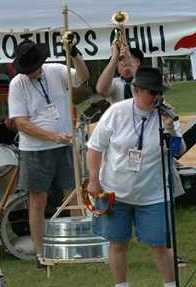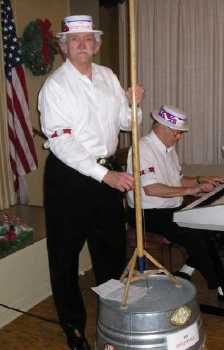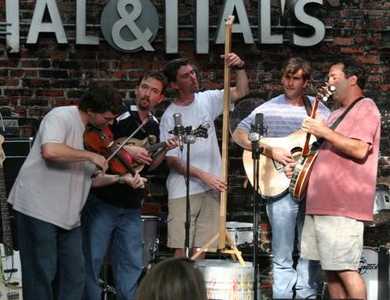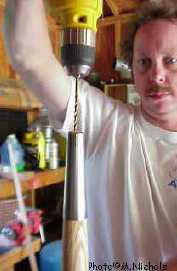
with Tub-O-Tone #J-156
| [Click HERE To Go to Washtub Bass Page] ---- [Click HERE To Close Window] THE TUB-O-TONE Special Features Free Plans Necessary Skills Construction Pics |
 |
| Builder Bill Lester with Tub-O-Tone #J-156 |
| WHAT'S SO SPECIAL ABOUT THE TUB-O-TONE? |
|---|
As you can see from the pictures, the Tub-O-Tone is a descendant of the washtub bass family of instruments. Its sound chamber is the old familiar galvanized tub, that workhorse of traditional American life, good for washing your sox and longjohns, hauling sand, collecting walnuts, or catching guts from a slaughtered hog. For a century or more, the washtub has also been the key component of the "gutbucket bass", providing the funky bottom line for many a downhome band. But there are big differences between a Tub-O-Tone and the classic washtub bass...
|
 |
| Tub-O-Tone #J-061 with Builder Paul Bourgeois |
| BUILD YOUR OWN -- FREE PLANS |
| Build your own Tub-O-Tone Model J from the free plans and instructions available via the Download Page. Click the links to download the files. |
 |
| Tub-O-Tone #J-112 and Builder Shawn Clark |
| THE NECESSARY SKILLS |
|---|
| Building the Tub-O-Tone requires no great shop skills-- mainly just the ability to read and follow the instructions, which are spelled out in great detail. Shade-tree techniques are explained to give an alternative to using expensive or complicated tools. A sabre saw is the most sophisticated tool required. But the cuts are not complicated, and the playability of the instrument does not depend on your woodcraft skills. Aside from the tub, the back panel and the hoe handle, no single component of the Tub-O-Tone costs more than $1.75, so there's lots of forgiveness in the project. And since the instrument is held together entirely with screws, any part of it can easily be replaced in upgrades of design, materials, or workmanship. For detailed information concerning the necessary tools, and the materials and hardware for the project, check out the Construction Pictures. |
 |
| Dan Pfeifer Drilling Neck for Tub-O-Tone #J-006 |
 |
| Optional Scroll Peghead for the Tub-O-Tone Model L |
| Back to Top |
| THE TUB-O-TONE Special Features Free Plans Necessary Skills Construction Pics |